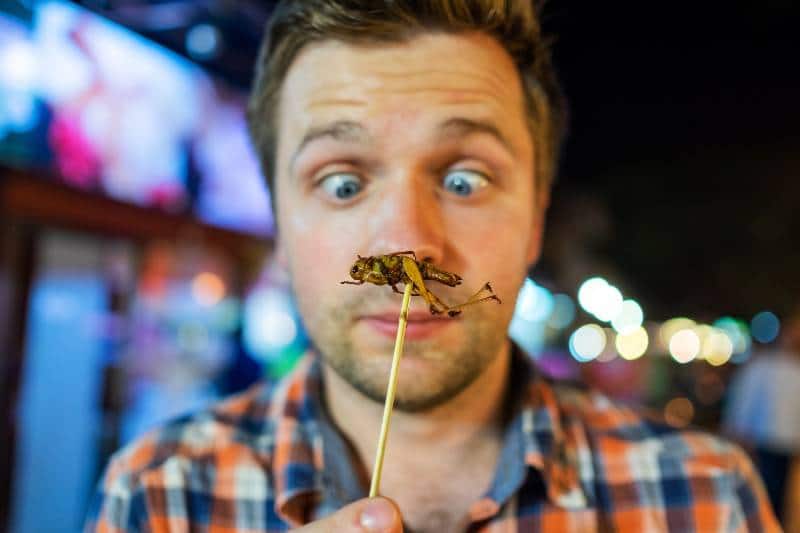Surviving the Buzz: Tackling Insects in Thailand (And More!)
Thailand is a beautiful and vibrant country, replete with tropical forests, stunning beaches, and diverse cultures. But beneath the exotic landscape lies another fascinating world – that of insects! From giant millipedes to brilliantly colored dragonflies, Thailand’s jungles are home to some truly incredible creatures. In this blog post, we’ll explore some of the weird and wonderful insect life native to Thailand and look at why it’s so important for us to preserve their habitats in order to protect future generations. So buckle up, grab your bug spray, and dive into an exploration of the wild kingdom right here in one of Southeast Asia’s most biodiverse countries!
Thailand’s rich biodiversity includes a vast array of insects. Dealing with these creatures requires understanding their behavior, employing prevention strategies, treating bites effectively, and respecting their ecological roles while ensuring personal health and comfort during your stay or travels.
Key Takeaways
- Understanding the types of insects found in Thailand, their habits, and the diseases they can carry is crucial to avoiding issues during your stay.
- Following practical tips to prevent insect bites and knowing how to deal with bites effectively is a must for both residents and travelers.
- While personal safety is essential, it’s important to remember and respect the role insects play in the ecosystem, ensuring our actions don’t negatively impact it.

Common Insects Found in Thailand
Thailand, a tropical paradise known for its vibrant culture, unique traditions, and rich biodiversity, also hosts an expansive range of insect species. Several of these insect species play essential roles in the ecosystem, from being crucial pollinators to serving as an integral part of the food chain. The most commonly encountered insects in Thailand include mosquitoes, ants, termites, cockroaches, and butterflies, among others. Here’s a detailed look into each of these:
Mosquitoes: One of the most prevalent insects in Thailand is the mosquito. There are several species of mosquitoes found in the country, including Aedes aegypti and Anopheles mosquitoes, known vectors of diseases like dengue fever and malaria, respectively. These tiny, buzzing insects, equipped with a proboscis for extracting blood from their hosts, are most active at dusk and dawn. Personal precautions, such as applying mosquito repellents and installing insect screens on windows, can minimize their annoyance and potential health risks.
Ants: Ants are ubiquitous throughout Thailand, with the country hosting hundreds of ant species. Among these, the Weaver Ant (Oecophylla smaragdina) and the Red Imported Fire Ant (Solenopsis invicta) are commonly found. These social insects live in colonies that can be seen in gardens, parks, and even in homes, searching for food with their characteristic discipline and coordination. While generally harmless, some species can deliver painful stings when disturbed.
Termites: Termites, often referred to as ‘white ants’, are wood-feeding insects commonly found in Thailand. The country’s tropical climate provides an ideal environment for them to thrive. These insects play a significant role in the ecosystem, aiding in the decomposition of wood and other plant matter. However, when they invade homes, they can cause substantial damage to wooden structures. Regular pest inspections and management can help control termite infestations.
Cockroaches: Cockroaches are another group of insects that are widespread in Thailand. The two most common species are the American cockroach (Periplaneta americana) and the German cockroach (Blattella germanica). Known for their resilience, cockroaches can often be found in homes, restaurants, and other buildings, especially in areas where food is stored or prepared. While not dangerous in a direct sense, they can carry disease-causing bacteria, contributing to health issues such as food poisoning.
Butterflies: Thailand is a haven for butterfly enthusiasts, with over a thousand species recorded in the country. One of the most iconic butterflies found in Thailand is the Common Tiger (Danaus genutia), a strikingly beautiful butterfly with white spots on a black or dark brown background and a series of orange and white streaks. Butterflies, apart from adding beauty to the environment, play a crucial role in pollination, helping in the growth of plants and flowers.
It’s important to remember that despite their sometimes bothersome presence or potential health risks, insects form an essential part of the ecological web. They aid in pollination, decomposition, and soil aeration, making them critical for the ecosystem. Therefore, it’s important to approach any need for control or eradication with a balanced view, considering their ecological significance and potential impacts on biodiversity.
Insect-Related Health Concerns
Insect-related health concerns are significant, especially in tropical and subtropical regions like Thailand, where the climate is conducive for a broad range of insects to thrive. Insects can act as vectors for several diseases, and some can cause allergic reactions. Let’s look at some case-specific details:
Dengue Fever: Dengue fever is a mosquito-borne disease caused by the dengue virus, which is transmitted to humans through the bite of an infected Aedes aegypti mosquito. This mosquito is prevalent in urban and semi-urban areas in Thailand. Symptoms of dengue fever include high fever, severe headache, pain behind the eyes, joint and muscle pain, rash, and mild bleeding. In severe cases, dengue can develop into dengue hemorrhagic fever, causing bleeding, blood plasma leakage, and low platelet count, which can be life-threatening.
Malaria: Malaria is another mosquito-borne disease, this time transmitted by the Anopheles mosquito. It’s caused by Plasmodium parasites that the mosquito carries. The symptoms of malaria include fever, headache, and chills, typically appearing 10-15 days after the infective mosquito bite. If not treated promptly, malaria can lead to severe illness and even death. While malaria is less common in urban and coastal areas of Thailand, it can be a risk in rural and forested areas.
Allergies and Skin Reactions: Some insects, such as ants, mosquitoes, and certain types of flies, can cause allergic reactions. Symptoms can range from mild to severe, including hives, itching, and swelling at the site of the bite or sting. Some people might experience more severe reactions like anaphylaxis, a life-threatening allergic reaction that requires immediate medical attention.
Lyme Disease: While less common in Thailand, ticks are known to transmit Lyme disease. It is a bacterial infection that presents symptoms such as fever, fatigue, headache, muscle and joint aches, and swollen lymph nodes, often accompanied by a characteristic skin rash. If left untreated, the infection can spread to joints, the heart, and the nervous system.
Leishmaniasis: Leishmaniasis is a disease caused by the bite of an infected sand fly. While not as common as dengue or malaria in Thailand, cases have been reported. It can cause skin ulcers and potentially affect internal organs in its more severe form (visceral leishmaniasis).
Prevention of insect-borne diseases primarily involves controlling the insect population and avoiding insect bites. Use of insect repellent, wearing protective clothing, and ensuring living areas are safe from insects, such as using bed nets and keeping surroundings clean, can be effective ways to prevent these diseases. Always seek immediate medical attention if you suspect you may have contracted an insect-borne illness.
Practical Tips for Avoiding Insects
Protecting yourself from insects, particularly in areas where they are prevalent, is an important aspect of maintaining good health. Here are some practical tips for avoiding insects:
- Dressing Appropriately: The way you dress can greatly influence your exposure to insects. For instance, wearing long-sleeved shirts and long pants can help protect your skin from mosquito and tick bites. Light-colored clothing can make it easier to spot ticks or other insects. Additionally, tucking your pants into your socks can provide an extra layer of protection, especially while hiking or walking in grassy or wooded areas.
- Using Insect Repellents: Insect repellents are a vital tool in the prevention of insect bites. Products containing DEET, Picaridin, or oil of lemon eucalyptus have been shown to be effective against a variety of insects. It’s important to apply repellents according to the instructions on the product label. For additional protection, permethrin, an insecticide, can be applied to clothing, shoes, camping gear, and bed nets. Permethrin-treated clothing can remain protective after multiple washings.
- Maintaining Clean Surroundings: Keeping your surroundings clean can help discourage insects from breeding and residing in your vicinity. For mosquitoes, it’s crucial to eliminate stagnant water sources, such as buckets, flower pots, or tires, where they lay their eggs. Regularly clean and empty pet water dishes and bird baths. For cockroaches and ants, make sure to store food in sealed containers, clean up food and drink spills promptly, and take out the trash regularly. Avoid leaving pet food out for extended periods.
- Installing Screens and Nets: To prevent insects from entering your home, install fine-mesh screens on windows and doors. For added protection, especially in regions with high mosquito or other insect populations, consider using a bed net while sleeping, preferably one treated with insecticide.
- Regular Pest Control: Regularly inspect your home for signs of infestations, such as termite mud tubes or damaged wood, ant trails, or cockroach droppings. Regular professional pest control services can also be beneficial in managing and preventing infestations.
- Being Aware of Peak Activity Times: Many insects, like mosquitoes, have peak activity times, often around dusk and dawn. If possible, try to avoid outdoor activities during these times. If you do need to be outside during these periods, ensure that you’re wearing protective clothing and using insect repellent.
By following these practical tips, you can significantly reduce your exposure to insects and the potential diseases they carry, ensuring a safer and more comfortable experience whether you’re at home or exploring the great outdoors.
Dealing with Insect Bites
First-aid Procedures
- Clean the Area: The first step is to clean the area with soap and water. This helps reduce the risk of infection.
- Apply a Cold Compress: Use a cold pack or a cloth dampened with cold water to reduce swelling and alleviate pain. Apply it to the affected area for about 10 to 15 minutes.
- Topical Treatments: Over-the-counter treatments, such as hydrocortisone cream or calamine lotion, can help soothe the area and reduce itching.
- Avoid Scratching: Though the bite or sting may itch, try not to scratch it. Scratching can break the skin and lead to infection.
- Pain Relief: If needed, over-the-counter pain relievers, such as ibuprofen, can help manage pain from the bite or sting.
When to Seek Medical Attention
In most cases, insect bites and stings are mild and can be treated at home. However, you should seek medical attention if:
- The symptoms become severe or worsen over time.
- You experience symptoms of an allergic reaction, such as difficulty breathing, swelling of the face or throat, rapid pulse, dizziness, or hives.
- The bite or sting site becomes increasingly painful, red, swollen, or develops pus, which could be signs of an infection.
- You’re bitten or stung by a dangerous insect, such as a scorpion or certain types of spiders.
- You develop flu-like symptoms after a tick bite, as this may be a sign of a tick-borne disease.
- You know or suspect that you’ve been bitten by a mosquito carrying a disease like dengue or malaria, particularly if you develop symptoms like high fever, severe headache, or joint and muscle pain.
Insect bites and stings can often be prevented by taking measures to avoid contact with insects. However, if you do get bitten or stung, quick and proper care can make a big difference in your comfort and recovery.
Home and Accommodation Remedies
Preventing insect infestations at home or in accommodations should be an ongoing endeavor. Several DIY solutions can help you maintain an insect-free environment, but professional help might be necessary for severe or persistent infestations. Here are some strategies to consider:
- DIY Solutions:
- Cleaning: Regular cleaning can help prevent many insect infestations. Clean up food and drink spills promptly, don’t leave dirty dishes out overnight, and take out the garbage regularly.
- Sealing Entry Points: Seal cracks, crevices, and other entry points with caulk to prevent insects from entering your home. Pay special attention to areas where pipes and wires enter the building.
- Proper Food Storage: Store food in airtight containers. Don’t leave ripe fruit out in the open for too long as it can attract fruit flies.
- Remove Standing Water: Standing water can serve as a breeding ground for mosquitoes. Remove any sources of stagnant water in or around your property, such as buckets, plant saucers, or old tires.
- Natural Repellents: Certain plants, like citronella, marigolds, and lavender, can help repel insects. Consider adding these to your garden or indoor spaces.
- DIY Traps: For certain pests like fruit flies, a simple DIY trap using a bowl, vinegar, and a paper funnel can be very effective.
- Professional Help:
- Pest Control Services: If your home or accommodation has a severe infestation or if DIY solutions aren’t working, it might be time to call a professional pest control service. These services have access to a range of products and methods to effectively deal with an infestation.
- Regular Inspections: For certain pests, like termites, regular professional inspections can help catch infestations early, preventing more significant damage.
- Accommodation-Specific Tips:
- Check Reviews: If you’re traveling, check reviews of your accommodations for mentions of pests.
- Inspect Your Room: When you arrive, inspect your room for signs of bed bugs or other pests.
- Use Luggage Racks: In hotel rooms, use luggage racks to keep your belongings off the floor and reduce the risk of pests hiding in your luggage.
Preventing insect infestations can make your living space more comfortable and can also help prevent potential health problems associated with some insects. Whether you’re managing the situation yourself or seeking professional help, the key is to act quickly at the first sign of an infestation.
Insect-proofing for Travellers
Traveling to new places, particularly tropical locations, often means exposure to a variety of insects. While these critters play a vital role in ecosystems, they can sometimes pose health risks to humans. So, if you’re planning a trip, here are some ways to insect-proof your travels and packing essentials to consider:
Special Advice for Travellers
Packing Essentials
Remember, the best way to deal with insect-borne diseases is to prevent bites in the first place. Utilize insect repellent, wear appropriate clothing, and sleep under a bed net if needed. Be vigilant, but don’t let worries about insects stop you from enjoying your travel adventure.
Respecting the Ecosystem
Insects, despite their potential to cause discomfort or transmit diseases, play an incredibly vital role in our ecosystems. They contribute to processes such as pollination, and decomposition, and serve as a food source for other creatures, which makes them an integral part of the biological chain. They even contribute to human endeavors, aiding in the production of honey, silk, and other products.
Therefore, it’s essential that we respect and protect them and their habitats, even as we seek to protect ourselves from the negative aspects of our interactions with them. Here are a few points of advice on how to respect nature while keeping oneself safe:
- Minimize Use of Pesticides: Pesticides can have detrimental effects on non-target insects and the broader ecosystem. Whenever possible, use eco-friendly pest control measures or opt for targeted treatments instead of broad-spectrum pesticides.
- Natural Repellents: Consider using natural insect repellents, such as citronella or oil of lemon eucalyptus, which are less harmful to the environment and non-target species. However, keep in mind that natural doesn’t always mean safe or effective, so always ensure you’re using products approved by a reliable authority like the EPA.
- Create Insect-Friendly Spaces: You can create insect-friendly spaces in your garden by planting native plants, providing water sources, and maintaining habitats like log piles or insect hotels. This encourages beneficial insects and helps maintain a balanced ecosystem.
- Litter Control: Litter can have harmful effects on wildlife and insects. Ensure you dispose of your waste properly, especially while camping or picnicking in natural areas.
- Education: Educate yourself and others about the importance of insects in our ecosystem and how to coexist safely with them. This awareness can lead to more respect for these tiny creatures and their important roles.
Remember, our goal should be to coexist harmoniously with insects, recognizing their essential place in the ecosystem while also taking steps to protect ourselves from the potential harm they can cause. It’s a delicate balance, but with knowledge and respect, it’s one that we can certainly achieve.
About The Edible Insect Industry in Thailand
There are several edible insects in Thailand that are gaining popularity as a source of sustainable and nutritious food. The industry has grown exponentially in recent years, with many businesses focusing on insect-based products such as flour, snacks, and even ice cream. Insect farming is also becoming more common, which helps to reduce the environmental impact of traditional meat production. Here are some edible insect species:
Fresh honey bee hive
Insects have been part of the diet in Thailand for generations and are generally considered both a delicacy and a valuable source of protein. The edible insect industry in Thailand is quite significant, with over 20,000 farms as of 2019. This industry generates tens of millions of dollars annually and supports a large number of small-scale farmers, especially in the country’s rural northeast region.
Insects are farmed in various ways, some being wild-harvested while others are farmed using modern methods. Commonly consumed insects in Thailand include crickets, silkworms, and certain types of beetles. These insects are usually cooked before being consumed, often being deep-fried and seasoned with Thai spices.
The Thai government has also supported the edible insect industry due to its environmental and economic benefits. Farming insects uses far less land and water than traditional livestock and produces less greenhouse gas. It also provides income to rural communities and is a sustainable way to provide high-quality protein to the country’s population.
Fresh Honey Bee Hive in Thailand
Honey bees are not only valuable for honey production, but also play a crucial role in pollination. In Thailand, beekeeping is a growing industry, with both wild and domesticated hives.
The most common bee species kept for honey production in Thailand is the Asian honey bee (Apis cerana). This species is smaller than the European honey bee (Apis mellifera) and is adapted to the local climate and flora.
Thai honey is prized for its unique flavors, which are influenced by the diverse flora from which the bees collect nectar. Depending on the location of the hive and the season, the taste of the honey can vary significantly.
Beekeepers in Thailand employ both traditional and modern beekeeping methods. Traditional beekeepers often allow bees to build natural hives in hollow logs or other cavities, while modern beekeepers use standardized hive boxes that allow for easier honey collection and better monitoring of bee health.
The honey industry in Thailand is not only important for the economic benefit it brings to beekeepers, but also for its contribution to sustainable agriculture and biodiversity conservation. By promoting pollination, bees help to increase crop yields and maintain the diversity of plant species.
Fresh subterranean ant eggs
Subterranean ant eggs, also known as ant larvae or pupae, are considered a delicacy in several parts of the world, including Thailand, Mexico, and other countries in Southeast Asia and Central America. They are typically harvested from nests of specific species of ants. In Thailand, the red weaver ants (Oecophylla smaragdina) are the main species harvested for their eggs.
Collecting ant eggs is a labor-intensive process. Harvesters must dig into the ants’ nests, often located underground or in trees, and carefully remove the eggs without damaging them or disturbing the ants too much. The ants are known to be quite protective of their eggs, so collecting them can be a challenging task.
Once collected, the ant eggs are usually washed and cooked. They can be boiled, fried, or roasted, and are often used in a variety of traditional dishes. In Thai cuisine, for example, ant eggs are used in a popular dish called “kai mod daeng,” where they are mixed with herbs and spices and served as a salad. They are valued for their unique flavor, which is often described as slightly sour, tangy, and nutty.
Ant eggs are also known to be highly nutritious. They are rich in protein, low in fat, and contain essential amino acids. Moreover, as with other edible insects, they are considered a sustainable food source as they require significantly less land, water, and food to produce compared to traditional livestock. As such, they are increasingly being recognized as part of the solution to food security and environmental sustainability challenges.
Fresh paper wasp larvae
Paper wasp larvae, like other edible insects, are considered a delicacy in certain regions, including parts of Asia and Latin America. In Thailand, they are traditionally harvested from the nests of paper wasps (genus Polistes), which are named for their characteristic paper-like nests made from chewed wood fibers.
Collecting paper wasp larvae can be a risky task due to the defensive nature of adult wasps, which can deliver painful stings when their nests are threatened. Harvesters must be careful not to disturb the colony excessively while extracting the larvae.
The larvae are typically collected from the combs within the wasp nest. After collection, they are usually cleaned and then cooked. Paper wasp larvae can be boiled, fried, or even eaten raw in certain traditional dishes. They are prized for their delicate, slightly sweet flavor and are often used in dishes that showcase their unique taste, such as in salads or as a topping for other dishes.
Like other edible insects, paper wasp larvae are highly nutritious. They are an excellent source of protein and also contain essential amino acids, vitamins, and minerals. They are an environmentally sustainable food source, requiring far less land, water, and food resources to produce than traditional livestock.
As interest in edible insects continues to grow worldwide due to their nutritional and environmental benefits, it’s possible we may see more focus on less commonly consumed species like paper wasps, although the challenges of safely harvesting them are significant.
Fried bamboo caterpillar larvae
Fried bamboo caterpillar larvae, also known as bamboo worms, are a popular snack and street food in various parts of Asia, particularly in Thailand and Laos. These caterpillars, the larvae of the moth Omphisa fuscidentalis, live and feed inside bamboo shoots, and are harvested before they mature into moths.
The process of farming bamboo caterpillars is quite unique. Bamboo plants are purposely inoculated with the moth’s eggs. The larvae then feed and grow within the bamboo until they are ready to be harvested. The bamboo is cut down and split open, and the plump, fully grown larvae are collected.
Once collected, they are typically cleaned and cooked. The most common method of cooking bamboo caterpillars is deep frying. They are often simply seasoned with salt after frying, though they can also be used in more complex dishes. The result is a crunchy snack that is rich in protein.
The taste of fried bamboo caterpillar larvae has been described as nutty and slightly sweet, with the consistency of fried shrimp. While they might be considered unusual or exotic to some, they are a traditional food in Thailand and Laos, and are becoming increasingly recognized as a sustainable source of nutrition.
With the growing interest in edible insects around the world due to their low environmental impact and high nutritional value, foods like fried bamboo caterpillar larvae are receiving more attention. This could lead to an expansion of their consumption beyond their traditional regions.
Giant water bugs
Giant water bugs, belonging to the family Belostomatidae, are a type of aquatic insect found in freshwater ponds, marshes, and slow-moving streams. They are one of the largest insects in the world, reaching up to 4 inches in length, and are notable for their large, powerful front legs which they use to capture their prey.
In several parts of Asia, particularly in Thailand, giant water bugs are considered a delicacy and used in various dishes. They are either collected from the wild or farmed in rice paddies.
Once caught, the bugs are typically boiled and then used in a number of ways. Some people eat the insects whole, while others extract the essence or juice to use as a flavoring in dishes. The bugs have a unique flavor that is often described as a mix of apple and banana, or compared to the taste of caviar. They’re also known for their strong, aromatic scent which comes from a type of pheromone males produce to attract females.
One of the most famous dishes that use giant water bugs is a Thai salad known as “yum maeng da”. The bugs can also be used to flavor nam prik, a spicy chili sauce, and certain types of curry.
Like other edible insects, giant water bugs are nutritious, rich in protein, and environmentally sustainable to harvest or farm. They’re an excellent example of how insects can contribute to food security and a diversified diet.
Frozen edible insect products
As the global interest in edible insects continues to rise, manufacturers and food processors have found various ways to present and sell insect-based products to consumers. Frozen edible insect products are one such form that allows for the preservation of the insects’ nutritional value while providing convenience to the consumer.
Here are a few examples of frozen edible insect products that may be available:
- Whole Insects: These are whole insects that have been frozen to preserve their freshness. They can be thawed and used as ingredients in a variety of dishes, or cooked and eaten as is. Examples might include crickets, mealworms, or locusts.
- Prepared Meals: These are ready-to-eat or ready-to-cook meals where insects are one of the primary ingredients. They might include dishes like cricket stir-fry, mealworm burgers, or silkworm pupa soup.
- Insect Flours or Powders: These products are made by drying and grinding insects into a fine powder or flour, which can be frozen to prolong shelf life. Insect flours can be used as a protein-rich substitute for traditional flours in baking and cooking.
- Snacks and Treats: Some manufacturers produce snacks or desserts featuring insects. These might include chocolate-covered crickets, insect protein bars, or ice cream made with insect milk or protein powder.
It’s worth noting that while the idea of consuming insects might seem unusual to some, insects are a common part of the diet in many cultures around the world. They’re rich in protein, vitamins, minerals, and fiber, and are considered a sustainable food source as they require significantly less land, water, and food to raise than traditional livestock.
Prepared edible insect products
There’s a growing interest in prepared edible insects ranging from canned to spreads worldwide, largely driven by a push towards more sustainable and environmentally friendly protein sources. The varieties of prepared edible insect products have greatly expanded in recent years, offering a wide range of options that cater to different consumer preferences. These products often come in convenient forms that are easy to cook, eat, and incorporate into various dishes.
In the category of canned edible insects, we have:
- Canned Whole Insects: This includes a variety of insects such as crickets, grasshoppers, silkworms, and mealworms. They are typically cooked and ready to eat straight from the can, or can be incorporated into other dishes. They may be seasoned or unseasoned, depending on the product.
- Insect Pâtés or Spreads: Some companies produce pâtés or spreads made from insects. These can be used in sandwiches, as a dip, or as an ingredient in cooking. Insect types used in these products include crickets, mealworms, and others.
- Insect-Based Soups and Broths: Some companies offer pre-packaged soups or broths made with insects. These might include silkworm pupa soup, cricket broth, and other varieties.
- Canned Insect Larvae: Certain types of insect larvae, such as bamboo worms and waxworms, are available in canned form. These are often used in traditional dishes in various cultures.
- Canned Insect-Based Meals: These are ready-to-eat meals with insects as one of the main ingredients. Examples might include chili made with cricket “mince,” or stir-fried bamboo worms.
- Insect Snacks: These are ready-to-eat snacks made with insects, like roasted crickets or mealworms, which are seasoned and can be eaten right out of the package.
- Insect-Based Pasta and Noodles: Some companies produce pasta and noodles made from insect flour, which can be stored dry or canned with sauces.
All of these products aim to make insects a more accessible and convenient food source for consumers. It’s also worth noting that the nutritional profile of insects is quite impressive, with high levels of protein, fiber, and other essential nutrients.

Insects in Thailand FAQs
How can I insect-proof my home or accommodation in Thailand?
When living in Thailand, it is essential to take measures to insect-proof your home or accommodation. This includes sealing all cracks and gaps in doors and windows, using screens on openings, and installing mosquito nets on beds. Another helpful tip is to keep the living space clean and free of clutter, which can attract pests. Additionally, using natural insect repellents such as essential oils and citronella candles can help ward off unwelcome visitors.
What are some effective insect repellents suitable for Thailand’s climate?
Visiting Thailand is truly a once-in-a-lifetime experience with its diverse landscape and bustling cityscapes. But with all that beauty comes the reality of mosquitoes and other pesky insects. Investing in a quality insect repellent ensures you won’t spend your entire trip itching and scratching.
Are there any particular insects I should avoid while travelling in Thailand?
While most are harmless and even fascinating, it’s important to know which ones to avoid. The most notable is the mosquito, which can carry diseases such as dengue fever and malaria. Another to avoid is the giant centipede, as its venomous bite can cause severe pain and swelling. It’s always best to take precautions and wear insect repellent, long-sleeved clothing, and closed-toe shoes when out exploring.
Are there any specific regions in Thailand with a higher risk of insect-borne diseases?
Be prepared for common Thailand diseases you may encounter including mosquito-borne diseases like malaria and dengue fever and how to get the best medical treatment. The risk of insect-borne diseases such as malaria and dengue fever is highest in the tropical areas of southern Thailand, but outbreaks can occur in other regions as well. It’s always best to take precautions like wearing insect repellent, long sleeves and pants, and sleeping under a mosquito net when traveling in these regions.
How can I respect the insect ecosystem while keeping myself safe?
First and foremost, it’s important to remember that insects play a vital role in our ecosystem and are not here simply to be exterminated. Without insects, our ecosystem would become unbalanced and unstable. That being said, it’s also important to keep yourself safe from any potential harm. If you’re worried about being stung or bitten by insects, it’s a good idea to wear protective clothing and use insect repellent. Additionally, if you’re dealing with an infestation in your home, consider using natural methods to control the problem instead of chemical pesticides.
Conclusion
There are many different types of insects living in Thailand, and it’s essential to know about them and how to protect yourself against them. While preparing for your trip, be sure to review the common insect species found in the region and learn about their habits to avoid potential issues. Additionally, prepare practical items like insect repellent and always be aware of where you step as certain bugs can lead to serious health risks if bitten.
Above all, remember that these creatures play an important role in our ecosystem, so consider how your actions may affect them. To keep yourself updated with more useful tips on Thailand travel safety, subscribe to our newsletter or reach out to us with any questions or concerns regarding your upcoming stay!






